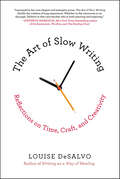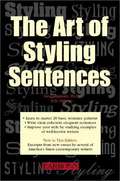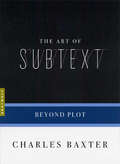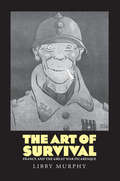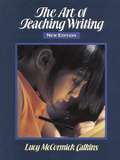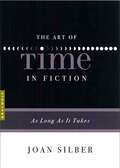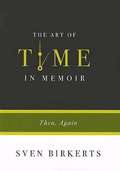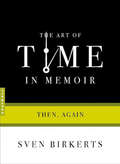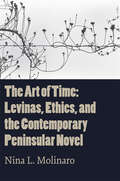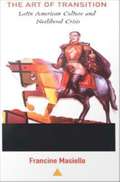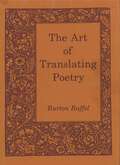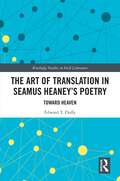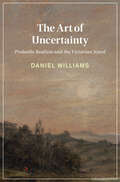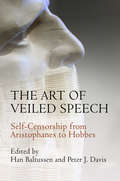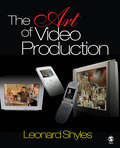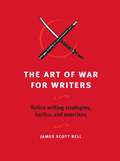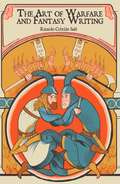- Table View
- List View
The Art of Shakespeare's Sonnets
by Helen VendlerHelen Vendler, widely regarded as our most accomplished interpreter of poetry, here serves as an incomparable guide to some of the best-loved poems in the English language. In detailed commentaries on Shakespeare's 154 sonnets, Vendler reveals previously unperceived imaginative and stylistic features of the poems, pointing out not only new levels of import in particular lines, but also the ways in which the four parts of each sonnet work together to enact emotion and create dynamic effect. The commentaries--presented alongside the original and modernized texts--offer fresh perspectives on the individual poems, and, taken together, provide a full picture of Shakespeare's techniques as a working poet. With the help of Vendler's acute eye, we gain an appreciation of "Shakespeare's elated variety of invention, his ironic capacity, his astonishing refinement of technique, and, above all, the reach of his skeptical imaginative intent. " Vendler's understanding of the sonnets informs her readings on an accompanying compact disk, which is bound with the book. This recorded presentation of a selection of the poems, in giving aural form to Shakespeare's words, heightens our awareness of voice in lyric, and adds the dimension of sound to poems too often registered merely as written words.
The Art of Slow Writing: Reflections on Time, Craft, and Creativity
by Louise DeSalvoIn a series of conversational observations and meditations on the writing process, The Art of Slow Writing examines the benefits of writing slowly.“DeSalvo turns what might have been an exercise in navel-gazing into a lively and inspiring guide for writers of all stripes. Buy two copies—the first will quickly sprout dog-ears.” —Publishers Weekly (starred review)The Art of Slow Writing examines the benefits of writing slowly, in a series of short, conversational chapters on the writing process. Louise DeSalvo advises readers to explore their creative process on deeper levels by getting to know themselves and their stories more fully over a longer period of time.DeSalvo includes anecdotes from classic American and international writers, such as John Steinbeck, Henry Miller, Virginia Woolf, and D.H. Lawrence, as well as contemporary authors such as Michael Chabon, Zadie Smith, Jeffrey Eugenides, Ian McEwan, and Donna Tart.The Art of Slow Writing is a gem of a book, a lovely, unhurried, meditative approach to writing that is truly the antidote to our 24/7 constant rush of a world, and DeSalvo is a skillful, patient, and thorough guide for anyone who is engaged in creative endeavors.“Leavened by her own elegant and energetic prose, The Art of Slow Writing distills the wisdom of long experience. Whether in the classroom or on the page, DeSalvo is that rare teacher who is both exacting and inspiring.” —Kathryn Harrison, New York Times–bestselling author of Enchantments, The Kiss, and The Binding Chair“I want to hand a copy to every writer I know and every writer I don’t know. This book is a gift. Its insights are unparalleled. . . . Read it more than once—the first time for pleasure and many more times for its invaluable insights into the craft.” —Margaux Fragoso, author of Tiger, Tiger: A Memoir“Wise and insightful. . . . A welcome reminder that in this fast-paced world, some things should not be rushed.” —Christina Baker Kline, #1 New York Times–bestselling author of Orphan Train
The Art of Social Excellence: How to Make Your Personal and Business Relationships Thrive
by Henrik FexeusHenrik Fexeus uses his expert psychology knowledge to teach the reader how to hone their social skills, perfect for fans of Dale Carnegie.Research has increasingly shown that nonverbal communication prowess is absolutely essential in seemingly unrelated areas of our lives (investment decisions, salary levels, etc.). However, as our society becomes more modernised and we incorporate new forms of technology into our daily interactions, we are becoming less and less capable of understanding one another as we should.In The Art of Social Excellence, Henrik Fexeus combines his own expert knowledge as a mentalist with psychology studies to create a complete guide to social interaction. He covers it all: from overcoming your conversational fears in a large group of people, to excelling in the workplace, to winning an argument with your partner. He breaks down various rhetorical strategies in detail and provides helpful steps and checklists for the reader to check their progress in a social encounter.Anyone who has ever felt awkward or misunderstood in social situations will benefit from reading this book, and with proper implementation of Fexeus' principles, can achieve superior social skills.
The Art of Styling Sentences: 20 Patterns for Success (4th edition)
by Ann Longknife K. D. Sullivan Marie L. WaddellAccepted writing style conventions change very slowly, but they do change. That is all the more reason why this favorite reference book for students, writers, and educators requires periodic updating. In this new edition, the authors review the fundamentals of correct sentence structure, then present twenty basic sentence patterns that encompass virtually every effective way of writing simple, compound, and complex sentences. They give advice on ways yo vary rhythm and sentence patterns to produce a more interesting writing style. Example sentences as well as brief essays by recognized writers are presented and analyzed. This brand-new edition, updated with many new examples of fine writing style, will inspire both students and seasoned writers to make their own essays sing.
The Art of Subtext: Beyond Plot (Art of...)
by Charles BaxterCharles Baxter inaugurates The Art of, a new series on the craft of writing, with the wit and intelligence he brought to his celebrated book Burning Down the House: Essays on Fiction.Fiction writer and essayist Charles Baxter's The Art of Subtext: Beyond Plot discusses and illustrates the hidden subtextual overtones and undertones in fictional works haunted by the unspoken, the suppressed, and the secreted. Using an array of examples from Melville and Dostoyevsky to contemporary writers Paula Fox, Edward P. Jones, and Lorrie Moore, Baxter explains how fiction writers create those visible and invisible details, how what is displayed evokes what is not displayed.The Art of Subtext is part of The Art of series, a new line of books by important authors on the craft of writing, edited by Charles Baxter. Each book examines a singular, but often assumed or neglected, issue facing the contemporary writer of fiction, nonfiction, or poetry. The Art of series means to restore the art of criticism while illuminating the art of writing.
The Art of Subtraction: Digital Adaptation and the Object Image
by Bruno LessardThe Art of Subtraction is the first full-length study on the CD-ROM as a creative platform. Bruno Lessard traces the rise and relatively rapid fall of the CD-ROM in the 1980s and 1990s and its impact as a creative platform for media artists such as Jean-Louis Boissier, Zoe Beloff, Adriene Jenik, and Chris Marker. Although the CD-ROM was not a lasting commercial success it was a vibrant medium that allowed for experimentation in adapting literary works. Building on the work of Gilles Deleuze and Michele Foucault, Lessard establishes a comparative framework for linking digital adaptations with innovative concepts such as 'subtractive adaptation' and the 'object image' that will be of interest to researchers examining literary adaptations on other digital platforms such as websites, smart phones, tablets, and digital games. The Art of Subtraction is a fascinating study of intermediality in the late twentieth century and it provides the first chapter in the yet unwritten history of digital adaptation.
The Art of Survival: France and the Great War Picaresque
by Libby MurphyAn astute literary and cultural history of World War I in France that offers a fresh perspective on the popular culture of the Great War The First World War soldier has often been depicted as a helpless victim sacrificed by a ruthless society in the trenches of the Western Front. In fact, Libby Murphy reveals, French soldiers drew upon a long-standing European tradition to imagine themselves not as heroes or victims but as survivors. Murphy investigates how infantrymen and civilians attempted to make sense of the war while it was still in progress by reviving the picaresque, a literary mode in which unheroic protagonists are forced to fend for themselves in a chaotic and hostile world. By examining works by French and European novelists, journalists, graphic artists, cultural critics, and filmmakers--including Charlie Chaplin--Libby Murphy shows how the rich tradition of the European picaresque was uniquely appropriate for expressing anxieties provoked by modern, industrialized warfare.
The Art of Teaching Writing, New Edition
by Lucy McCormick CalkinsWhen Lucy Calkins wrote the first edition of The Art of Teaching Writing, the writing workshop was a fledgling idea, piloted by a few brave innovators. Now, as she brings us this new edition, the writing workshop is at the foundation of language arts education throughout the English-speaking world. This new edition, then, could easily have been a restatement, in grander, more confident tones, of the original classic. Instead, it is an almost entirely new book. <P><P>Clearly, during the time in which Calkins's original ideas have spread like wildfire, her focus has not been on articulating and defending those ideas, but on developing and rethinking them. Respecting and responding to the questions which have arisen as thousands of teachers establish writing workshops in their classrooms, and drawing upon the latest knowledge in the field and her own intimate understanding of classroom life, Calkins has re-thought every line and every facet of her original text. <P><P>In this new edition, Lucy has major new chapters on assessment, thematic studies, writing throughout the day, reading/writing relationships, publication, curriculum development, nonfiction writing and home/school connections. More than this, she has deepened her understanding of the writing process itself: <P><P>"When I wrote the first edition, I saw writing as a process of choosing a topic, turning the topic into the best possible draft, sharing the draft with friends, then revising it. But I've come to think that it's very important that writing is a process not only of recording, but also of developing a story or an idea. Now, in this new edition, I describe writing episodes that do not begin with a topic and a draft but instead with something noticed or something wondered about. When writing begins with something that has not yet found its significance, it is more apt to become a process of growing meaning."
The Art of Time in Fiction: As Long as It Takes (Art of...)
by Joan SilberFiction imagines for us a stopping point from which life can be seen as intelligible," asserts Joan Silber in The Art of Time in Fiction. The end point of a story determines its meaning, and one of the main tasks a writer faces is to define the duration of a plot. Silber uses wide-ranging examples from F. Scott Fitzgerald, Chinua Achebe, and Arundhati Roy, among others, to illustrate five key ways in which time unfolds in fiction. In clear-eyed prose, Silber elucidates a tricky but vital aspect of the art of fiction.
The Art of Time in Memoir: Then, Again
by Sven BirkertsSven Birkerts is the author of Reading Life: Books for the Ages, Readings, The Gutenberg Elegies, and a memoir, My Sky Blue Trades. He teaches at Harvard University and at the Bennington Writing Seminars and is the editor of AGNI. He lives in Arlington, Massachusetts. In The Art of Time in Memoir, critic, editor, and memoirist Sven Birkerts examines the human impulse to write about the self. "Memoir is, for better and often for worse, the genre of our times," Birkerts writes. But what makes one memoir memorable and another self-serving? What determines the difference between graceful disclosure and sensational self-exposure? Birkerts argues that the memoirist's strategies for presenting the subjective experience of time reveal the power and resonance of the writer's life. By examining memoirs such as Vladimir Nabokov's Speak, Memory, Virginia Woolf's unfinished A Sketch of the Past, and Mary Karr's The Liar's Club, Birkerts describes the memoirist's essential art of assembling patterns of meaning, how the work stirs to life our own sense of past and present. The Art of Time in Memoir is part of The Art of series, a new line of books by important authors on the craft of writing, edited by Charles Baxter. Each book examines a singular, but often assumed or neglected, issue facing the contemporary writer of fiction, nonfiction, or poetry. The Art of series means to restore the art of criticism while illuminating the art of writing. Of the series, Baxter writes, "The Art Of series is meant to restore criticism as an art, with writers examining features of their craft in lively and colorful prose. " "Respected critic Birkerts has written an insightful appreciation of the memoir form, works that occupy a growing ... place in our literary culture. Analyzing five ways different writers have chosen to transform their memories into coherent narrative, Birkerts discerns the underlying principle of the memoir form: balancing two perspectives by revisiting significant events in the past to discover a pattern in one's present life ... The appeal of this slim volume lies in Birkert's graceful prose and lucid analysis. "-Publishers Weekly". Respected critic Birkerts has written an insightful appreciation of the memoir form, works that occupy a growing ... place in our literary culture. Analyzing five ways different writers have chosen to transform their memories into coherent narrative, Birkerts discerns the underlying principle of the memoir form: balancing two perspectives by revisiting significant events in the past to discover a pattern in one's present life. Nabokov, Virginia Woolf and Annie Dillard are what he calls the Lyrical Seekers, who use sensuous apprehension to explore the nature of being. Frank Conroy's Stop-Time is one of the examples of the coming-of-age memoir, as is Birkerts's own My Sky Blue Trades. Fathers and sons, e. g. , Paul Auster, Geoffrey Wolff and Blake Morrison, are distinguished from mothers and daughters, e. g. , Jamaica Kincaid and Vivian Gornick. Finally, works by Mary Karr and Lucy Grealy are among those illustrating the category of trauma and memory. The appeal of this slim volume lies in Birkert's graceful prose and lucid analysis. Written for the general reader, it artfully conveys the basics of the craft and will be a particular boon to reading groups. "-Publishers Weekly.
The Art of Time in Memoir: Then, Again (Art of...)
by Sven BirkertsThe Art Of series is a new line of books reinvigorating the practice of craft and criticism. Each book will be a brief, witty, and useful exploration of fiction, nonfiction, or poetry by a writer impassioned by a singular craft issue. The Art Of volumes will provide a series of sustained examinations of key but sometimes neglected aspects of creative writing by some of contemporary literature's finest practioners.In The Art of Time in Memoir, critic and memoirist Sven Birkerts examines the human impulse to write about the self. By examining memoirs such as Vladimir Nabokov's Speak, Memory; Virginia Woolf's unfinished A Sketch of the Past; and Mary Karr's The Liars' Club, Birkerts describes the memoirist's essential art of assembling patterns of meaning, stirring to life our own sense of past and present.
The Art of Time: Levinas, Ethics, and the Contemporary Peninsular Novel
by Nina L MolinaroEthics, or the systematized set of inquiries and responses to the question “what should I do?” has infused the history of human narrative for more than two centuries. One of the foremost theorists of ethics during the twentieth century, Emmanuel Levinas (1906-1995) radicalized the discipline of philosophy by arguing that “the ethical” is the foundational moment for human subjectivity, and that human subjectivity underlies all of Western philosophy. Levinas’s voice is crucial to the resurging global attention to ethics because he grapples with the quintessential problem of alterity or “otherness,” which he conceptualizes as the articulation of, and prior responsibility to, difference in relation to the competing movement toward sameness. Academicians and journalists in Spain and abroad have recently fastened on an emerging cluster of peninsular writers who, they argue, pertain to a discernible literary generation, provisionally referred to as Generación X. These writers are distinct from their predecessors; they and their literary texts are closely related to the specific socio-political and historical circumstances in Spain; and their novels relate stories of more and less proximity, more and less responsibility, and more and less temporality. In short, they trace the temporal movement of alterity through narrative. Published by Bucknell University Press. Distributed worldwide by Rutgers University Press.
The Art of Transition: Latin American Culture and Neoliberal Crisis
by Francine MasielloThe Art of Transition addresses the problems defined by writers and artists during the postdictatorship years in Argentina and Chile, years in which both countries aggressively adopted neoliberal market-driven economies. Delving into the conflicting efforts of intellectuals to name and speak to what is real, Francine Masiello interprets the culture of this period as an art of transition, referring to both the political transition to democracy and the formal strategies of wrestling with this change that are found in the aesthetic realm. Masiello views representation as both a political and artistic device, concerned with the tensions between truth and lies, experience and language, and intellectuals and the marginal subjects they study and claim to defend. These often contentious negotiations, she argues, are most provocatively displayed through the spectacle of difference, which constantly crosses the literary stage, the market, and the North/South divide. While forcefully defending the ability of literature and art to advance ethical positions and to foster a critical view of neoliberalism, Masiello especially shows how issues of gender and sexuality function as integrating threads throughout this cultural project. Through discussions of visual art as well as literary work by prominent novelists and poets, Masiello sketches a broad landscape of vivid intellectual debate in the Southern Cone of Latin America. The Art of Transition will interest Latin Americanists,literary and political theorists, art critics and historians, and those involved with the study of postmodernism and globalization.
The Art of Translating Poetry
by Burton RaffelThis book by a well-known translator and critic is divided into two parts, the first dealing with the linguistic and other more technical aspects of translating poetry, the second involved with more practice-oriented matters. The chapters in Part One examine the specific constraints of language and the unavoidable linguistic bases of translation; the constraints of specific languages; forms and genres; and prosody and comparative prosody. Part Two looks at the subjective element in translation; collaborative translation; the translation of oral poetry; and the translator's responsibility.Languages discussed include Indonesian, Japanese, Chinese, Old and Middle English, French, German, Spanish, Italian, Persian, Russian, Latin, and Greek. The book argues, inter alia, that literal translation is impossible; that no translation can fully create the original but that good literary translation can create a usable approximation; that translation is secondary not only to the original work being translated but also to the linguistic (and literary) nature of the language being translated into; that the literary translator's primary responsibility is to the work he is translating; that there is nothing ever definitive about any translation; that the poetry translator must be a poet and poems should not be translated into prose; and that there must be a subjective identification between translator and translated work.This is the first attempt to systematize linguistic information about the translation of poetry. It is also the first book to range widely over the languages and literatures of the past and the present, and European and Asian languages and literatures as well. Raffel is the first author to combine in one study linguistic and scholarly knowledge and extensive experience of translation.
The Art of Translating Poetry
by Burton RaffelThis book by a well-known translator and critic is divided into two parts, the first dealing with the linguistic and other more technical aspects of translating poetry, the second involved with more practice-oriented matters. The chapters in Part One examine the specific constraints of language and the unavoidable linguistic bases of translation; the constraints of specific languages; forms and genres; and prosody and comparative prosody. Part Two looks at the subjective element in translation; collaborative translation; the translation of oral poetry; and the translator's responsibility.Languages discussed include Indonesian, Japanese, Chinese, Old and Middle English, French, German, Spanish, Italian, Persian, Russian, Latin, and Greek. The book argues, inter alia, that literal translation is impossible; that no translation can fully create the original but that good literary translation can create a usable approximation; that translation is secondary not only to the original work being translated but also to the linguistic (and literary) nature of the language being translated into; that the literary translator's primary responsibility is to the work he is translating; that there is nothing ever definitive about any translation; that the poetry translator must be a poet and poems should not be translated into prose; and that there must be a subjective identification between translator and translated work.This is the first attempt to systematize linguistic information about the translation of poetry. It is also the first book to range widely over the languages and literatures of the past and the present, and European and Asian languages and literatures as well. Raffel is the first author to combine in one study linguistic and scholarly knowledge and extensive experience of translation.
The Art of Translation in Seamus Heaney’s Poetry: Toward Heaven (Routledge Studies in Irish Literature)
by Edward T. DuffyThe Art of Translation in Seamus Heaney’s Poetry is a critical study of the poet's later work. While exploring his practice as a translator, it also traces his increasing preoccupation with the possibilities and conditions of translation in the theological sense of being lifted up in spirit. To the work of this philosophical poet, who would be both “earthed and heady” this book brings the insights of ordinary language philosophy as practiced by Stanley Cavell. It devotes separate chapters to Station Island and three later collections: Seeing Things, Electric Light and Human Chain. The first of these addresses the most fundamental change in Heaney’s life when he acknowledges the “need and chance to re-envisage” his Irish-Catholic upbringing; it is also replete with both the activity and the trope of translation. Published seven years later, Seeing Things begins with a translation of Virgil’s golden bough episode and ends with a similar crossing over into the underworld by Dante. Heaney transforms both into poems about poetry. In Electric Light, Heaney returns to Virgil, but now he concentrates not on the hero of the Aeneid but on Virgil's earlier efforts in pastoral, a mode of writing that Heaney takes as a model for his own time and place of “devastated order.” Heaney returns to the Aeneid in Human Chain, but this time around he gives all his attention to the scene of the human souls in Elysium seeking rebirth and turns it into an image for the need and chance of pronouncing “a final Yes” to our world and our place in it.
The Art of Twentieth-century American Poetry: Modernism and After
by Charles AltieriWritten by a leading critic, this invigorating introduction to modernist American poetry conveys the excitement that can be generated by a careful reading of modernist poems. Encourages readers to identify with the modernists' sense of the revolutionary possibilities of their art. Embraces four generations of modernist American poets up through to the 1980s. Gives readers a sense of the ambitions, the disillusionments and the continuities of modernist poetry. Includes close readings of particular poems which show how readers can use these works to connect with what concerns them.
The Art of Uncertainty: Probable Realism and the Victorian Novel (Cambridge Studies in Nineteenth-Century Literature and Culture)
by Daniel WilliamsThe Victorian novel developed unique forms of reasoning under uncertainty-of thinking, judging, and acting in the face of partial knowledge and unclear outcome. George Eliot, Wilkie Collins, William Thackeray, Thomas Hardy, and later Joseph Conrad drew on science, mathematics, philosophy, and the law to articulate a phenomenology of uncertainty against emergent models of prediction and decision-making. In imaginative explorations of unsure reasoning, hesitant judgment, and makeshift action, these novelists cultivated distinctive responses to uncertainty as intellectual concern and cultural disposition, participating in the knowledge work of an era shaped by numerical approaches to the future. Reading for uncertainty yields a rich account of the dynamics of thinking and acting, a fresh understanding of realism as a genre of the probable, and a vision of literary-critical judgment as provisional and open-ended. Daniel Williams spotlights the value of literary art in a present marked by models and technologies of prediction.
The Art of Veiled Speech: Self-Censorship from Aristophanes to Hobbes
by Han Baltussen Peter J. DavisThroughout Western history, there have been those who felt compelled to share a dissenting opinion on public matters, while still hoping to avoid the social, political, and even criminal consequences for exercising free speech. In this collection of fourteen original essays, editors Han Baltussen and Peter J. Davis trace the roots of censorship far beyond its supposed origins in early modern history.Beginning with the ancient Greek concept of parrhêsia, and its Roman equivalent libertas, the contributors to The Art of Veiled Speech examine lesser-known texts from historical periods, some famous for setting the benchmark for free speech, such as fifth-century Athens and republican Rome, and others for censorship, such as early imperial and late antique Rome. Medieval attempts to suppress heresy, the Spanish Inquisition, and the writings of Thomas Hobbes during the Reformation are among the examples chosen to illustrate an explicit link of cultural censorship across time, casting new light on a range of issues: Which circumstances and limits on free speech were in play? What did it mean for someone to "speak up" or "speak truth to authority"?Drawing on poetry, history, drama, and moral and political philosophy the volume demonstrates the many ways that writers over the last 2500 years have used wordplay, innuendo, and other forms of veiled speech to conceal their subversive views, anticipating censorship and making efforts to get around it. The Art of Veiled Speech offers new insights into the ingenious methods of self-censorship to express controversial views, revealing that the human voice cannot be easily silenced.Contributors: Pauline Allen, Han Baltussen, Megan Cassidy-Welch, Peter J. Davis, Andrew Hartwig, Gesine Manuwald, Bronwen Neil, Lara O'Sullivan, Jon Parkin, John Penwill, François Soyer, Marcus Wilson, Ioannis Ziogas.
The Art of Video Production
by Dr Leonard C. ShylesThe Art of Video Production emphasizes the enduring principles and essential skills of the communication process and the new digital technologies that are necessary to create effective video content. Author Leonard C. Shyles uses a unique approach by explaining how things are done and why things are done rather than just that they are done—it is not about concepts versus skills, but about concepts and skills.
The Art of Voice: Poetic Principles And Practice
by Tony HoaglandAn award-winning poet, teacher, and “champion of poetry” (New York Times) demystifies the elusive element of voice. In this accessible and distilled craft guide, acclaimed poet Tony Hoagland approaches poetry through the frame of poetic voice, that mysterious connective element that binds the speaker and reader together. A poem strong in the dimension of voice is an animate thing of shifting balances, tones, and temperatures, by turns confiding, vulgar, bossy, or cunning—but above all, alive. The twelve short chapters of The Art of Voice explore ways to create a distinctive poetic voice, including vernacular, authoritative statement, material imagination, speech register, tone-shifting, and using secondary voices as an enriching source of texture in the poem. A comprehensive appendix contains thirty stimulating models and exercises that will help poets cultivate their craft. Mining his personal experience as a poet and analyzing a wide range of examples from Catullus to Marie Howe, Hoagland provides a lively introduction to contemporary poetry and an invaluable guide for any practicing writer.
The Art of Walking in London: Representing the Eighteenth-Century City, 1700–1830
by Alison O'ByrneExploring a variety of perspectives on London during the long eighteenth century, this study considers how walking made possible the various surveys and tours that characterized accounts of the capital. O'Byrne examines how walking in the city's streets and promenades provided subject matter for writers and artists. Engaging with a wide range of material, the book ranges across and investigates the various early eighteenth-century works that provided influential models for representing the city, descriptions of the promenade in St. James's Park, accounts of London that imagine the needs and interests of tourists, popular surveys of the cheats and frauds of the city uncovered on a ramble through London, and comic explorations of the pleasures and pitfalls of urban living produced in the late eighteenth and early nineteenth century. Convincing and engaging, O'Byrne demonstrates the fundamental role played by walking in shaping representations of the eighteenth- and early nineteenth-century city.
The Art of War for Writers: Fiction Writing Strategies, Tactics, and Exercises
by James Scott BellStrategies and Tactics for the Master NovelistSuccessfully starting and finishing a publishable novel is often like fighting a series of battles. You not only have to work hard to shape memorable characters, develop gripping plots, and craft dazzling dialogue, but you also have to fight against self-doubts and fears. And then there's the challenge of learning to navigate the ever-changing publishing industry.That's why best-selling novelist James Scott Bell, author of the Write Great Fiction staples Plot & Structure and Revision & Self-Editing, came up with the ultimate novel-writing battle plan: The Art of War for Writers.You'll find tactics and strategies for idea generation and development, character building, plotting, drafting, querying and submitting, dealing with rejection, coping with unrealistic expectations, and much more.With timeless, innovative, and concise writing reflections and techniques, The Art of War for Writers is your roadmap to victory.
The Art of War for Writers: Fiction Writing Strategies, Tactics, and Exercises
by James Scott BellStrategies and Tactics for the Master NovelistSuccessfully starting and finishing a publishable novel is often like fighting a series of battles. You not only have to work hard to shape memorable characters, develop gripping plots, and craft dazzling dialogue, but you also have to fight against self-doubts and fears. And then there's the challenge of learning to navigate the ever-changing publishing industry.That's why best-selling novelist James Scott Bell, author of the Write Great Fiction staples Plot & Structure and Revision & Self-Editing, came up with the ultimate novel-writing battle plan: The Art of War for Writers.You'll find tactics and strategies for idea generation and development, character building, plotting, drafting, querying and submitting, dealing with rejection, coping with unrealistic expectations, and much more.With timeless, innovative, and concise writing reflections and techniques, The Art of War for Writers is your roadmap to victory.
The Art of Warfare and Fantasy Writing
by Nadia Hleb Ricardo Cebrián SaléThis is not one of those books that suggests reading Sun Tzu's The Art of War even on the toilet, but rather gives practical tips to help inexperienced writers with their battles… With the help of various acclaimed authors and real historical examples, you’ll learn: *What to keep in mind when designing a battle *What types of weapons exist and why they’re used *Different real tactics that you can apply *Different options for narrating a battle

